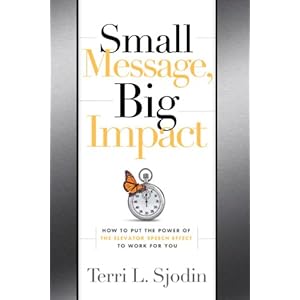I was recently given an advanced reader copy of Small Message, Big Impact by Terri L. Sjodin. It’s a book on crafting an effective and persuasive elevator speech.

An elevator speech is, according the the author, “a brief presentation introducing a product, service, philosophy or an idea. The name suggests the notion that the message should be delivered in the time span of an elevator ride, up to about 3 minutes. Its general purpose is to intrigue and inspire a listener to want to hear more of the presenter’s complete proposition in the near future.” It’s a 3-minute speech you give to intrigue someone enough that they will let you give a real presentation.
A lot of people–probably most–use their 3 minutes of unexpected access as an “information dump”. They pour as much data as possible into their audience. According to Sjodin(and I agree!), and elevator speech needs to be primarily persuasive, not informative. You need to include enough information to back up your persuasive arguments, but too much information is at least as bad, if not worse, than too little.
An elevator speech is either a sales pitch or a waste of time. You are selling the right to give more detailed information at a later time. The elevator pitch is not about making the sale. It’s about advancing the ball toward the eventual sale.
Who needs an elevator pitch? You do. Everybody sells. Even if you don’t have a product, a service, or a business, you have yourself. Can you pitch your boss on why you deserve a raise or a promotion?
The author walks you through creating an elevator speech that takes advantage of Monroe’s Motivated Sequence to advance your goal, whatever that is. She’ll teach you how to grab your audience’s attention and make them recognize a need for change. You’ll offer a solution, help them see the super-ninja-awesome future you’re offering, and give them a clear call to action. All in 3 to 5 minutes. Small Message, Big Impact will also teach you to provide a clear progression through those steps, making it easy for your target to say yes.
You’ll learn the basic outline of an elevator speech, including how to grab your target’s interest, build a persuasive case, and establish credibility when you’ve been surprised with a few moments of access. The three pieces of any successful presentation, from an elevator speech to a full-day presentation are
- Case. If you can’t make your case, nothing else matters.
- Creativity. You won’t win by being the same as everyone else. The same product, the same service, the same buzzwords won’t differentiate yourself from the competition.
- Delivery. Stumbling, stammering, and talking to the wall will make the the best product and the most creative presentation sound like crap, every time. You need to build your presentation and practice it, so you come across and smooth an knowledgeable.
One of the best ways to sound credible, which will assist your delivery like nothing else, is to use an authentic voice. Be sincere and sound it. Believe in the material and yourself. Know the material–inside and out–and practice it until you can deliver it smoothly, even if that means enlisting a friend for speech practice.
Of the books I’ve reviewed, I think this is my favorite. If you need to design an elevator speech or improve the one you’ve been using, you should read this book. Even if you don’t care about an elevator speech, the book provides a decent education on persuasive selling that easily carries over to the written word.
How would you(or do you) use an elevator speech?

 (Jack) and Donna (Hasbrouck) Dwire on March 25th, 1951 in Park Rapids, MN. Mark graduated from Walker/Hackensack High School in 1969. He was married to Sherry (Garbers) Dwire on July 31st, 1971. Mark was a business entrepreneur. He started as a logger when you could still make a living with a chainsaw and a tractor.
(Jack) and Donna (Hasbrouck) Dwire on March 25th, 1951 in Park Rapids, MN. Mark graduated from Walker/Hackensack High School in 1969. He was married to Sherry (Garbers) Dwire on July 31st, 1971. Mark was a business entrepreneur. He started as a logger when you could still make a living with a chainsaw and a tractor.



